android如何查看cpu的占用率和内存泄漏
Android应用性能测试从CPU到内存全方位分析

Android应用性能测试从CPU到内存全方位分析在进行Android应用性能测试时,从CPU到内存的全方位分析是非常重要的。
这种分析可以帮助开发者确定应用程序的性能瓶颈,并优化其性能,以提供更好的用户体验。
本文将探讨如何进行Android应用性能测试,并针对性能测试的各个方面进行详细分析。
一、CPU性能测试1.1 硬件环境准备在进行CPU性能测试之前,需要提前准备好测试环境。
首先,确保使用一台配置较高的Android手机或使用模拟器。
其次,关闭所有后台运行的应用程序,以确保测试结果的准确性。
1.2 测试工具选择Android平台上有许多可用于测试CPU性能的工具,比如AnTuTu Benchmark、Geekbench等。
开发者可以根据实际需求选择合适的工具。
1.3 测试指标及结果分析在进行CPU性能测试时,开发者需要关注以下指标:- 单核性能:测试设备在单核处理器上的性能表现。
- 多核性能:测试设备在多核处理器上的性能表现。
- CPU温度:测试设备在高负载情况下的温度表现。
通过测试工具运行测试后,开发者可以根据得到的结果进行分析和优化。
比如,如果单核性能较低,可以考虑优化应用程序的算法或减少不必要的计算过程。
二、内存性能测试2.1 内存使用监测在进行内存性能测试之前,首先需要监测应用程序的内存使用情况。
Android平台提供了内存监测工具,如Android Profiler等。
通过监测内存使用,可以了解应用程序的内存占用情况,并找出可能存在的内存泄漏问题。
2.2 内存泄漏检测内存泄漏是Android应用开发中常见的问题之一。
为了检测内存泄漏,开发者可以使用Profiling工具来分析应用程序的堆转储文件。
通过分析堆转储文件,可以找出那些没有被垃圾回收器释放的对象,从而确定是否存在内存泄漏问题。
2.3 内存优化根据内存性能测试的结果,开发者可以进行相应的优化。
比如,可以优化应用程序的内存管理策略,减少不必要的内存占用。
Android App内存泄露测试方法总结
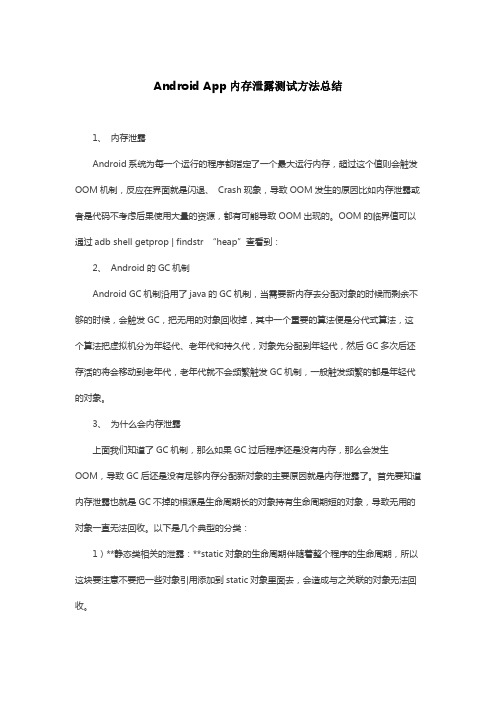
Android App内存泄露测试方法总结1、内存泄露Android系统为每一个运行的程序都指定了一个最大运行内存,超过这个值则会触发OOM机制,反应在界面就是闪退、Crash现象,导致OOM发生的原因比如内存泄露或者是代码不考虑后果使用大量的资源,都有可能导致OOM出现的。
OOM的临界值可以通过adb shell getprop | findstr “heap”查看到:2、Android的GC机制Android GC机制沿用了java的GC机制,当需要新内存去分配对象的时候而剩余不够的时候,会触发GC,把无用的对象回收掉,其中一个重要的算法便是分代式算法,这个算法把虚拟机分为年轻代、老年代和持久代,对象先分配到年轻代,然后GC多次后还存活的将会移动到老年代,老年代就不会频繁触发GC机制,一般触发频繁的都是年轻代的对象。
3、为什么会内存泄露上面我们知道了GC机制,那么如果GC过后程序还是没有内存,那么会发生OOM,导致GC后还是没有足够内存分配新对象的主要原因就是内存泄露了。
首先要知道内存泄露也就是GC不掉的根源是生命周期长的对象持有生命周期短的对象,导致无用的对象一直无法回收。
以下是几个典型的分类:1)**静态类相关的泄露:**static对象的生命周期伴随着整个程序的生命周期,所以这块要注意不要把一些对象引用添加到static对象里面去,会造成与之关联的对象无法回收。
2)各种资源的释放:包括cursor的关闭,IO流的关闭,bitmap的回收等,进行一些带有缓存的资源一定要关闭或者释放。
3)Handler的泄露:调用handler的delay的时候,会被认为对象是有用的,导致无法回收,还有handler开启线程去下载东西没有下载完成的时候,也会因为线程导致无法回收activity;或者使用handlerThread的时候,有延迟的方法,都会导致无法回收。
其主要原因在于handler是持有activity的引用,主线程不是自带一个Looper然后给handler用,导致有关联关系。
Android测试如何进行内存和性能优化
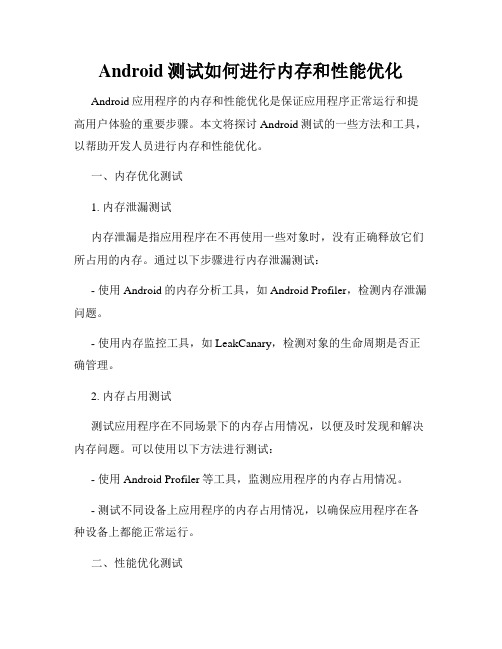
Android测试如何进行内存和性能优化Android应用程序的内存和性能优化是保证应用程序正常运行和提高用户体验的重要步骤。
本文将探讨Android测试的一些方法和工具,以帮助开发人员进行内存和性能优化。
一、内存优化测试1. 内存泄漏测试内存泄漏是指应用程序在不再使用一些对象时,没有正确释放它们所占用的内存。
通过以下步骤进行内存泄漏测试:- 使用Android的内存分析工具,如Android Profiler,检测内存泄漏问题。
- 使用内存监控工具,如LeakCanary,检测对象的生命周期是否正确管理。
2. 内存占用测试测试应用程序在不同场景下的内存占用情况,以便及时发现和解决内存问题。
可以使用以下方法进行测试:- 使用Android Profiler等工具,监测应用程序的内存占用情况。
- 测试不同设备上应用程序的内存占用情况,以确保应用程序在各种设备上都能正常运行。
二、性能优化测试1. 响应时间测试测试应用程序的响应时间,以确保用户在使用应用程序时能够得到良好的体验。
以下是一些测试方法:- 使用性能测试工具,如JMeter,对应用程序进行负载测试,模拟多用户同时访问应用程序的情况,以评估应用程序的响应速度。
- 测试应用程序在不同网络条件下的响应时间,以确保应用程序在各种网络环境下都能提供良好的用户体验。
2. CPU利用率测试测试应用程序的CPU利用率,以评估应用程序的性能。
以下是一些测试方法:- 使用性能测试工具,如MonkeyRunner,对应用程序进行压力测试,模拟大量用户同时操作应用程序,以评估应用程序的CPU利用率。
- 测试应用程序在不同设备上的CPU利用率,以确保应用程序在各种设备上都能正常运行。
3. 界面渲染性能测试测试应用程序的界面渲染性能,以确保应用程序的界面能够流畅地显示。
以下是一些测试方法:- 使用UI性能测试工具,如UI Automator,对应用程序的界面进行性能测试,评估界面渲染的速度和流畅度。
利用Android Studio进行性能分析

利用Android Studio进行性能分析在本文中,我们将探讨如何使用Android Studio进行性能分析。
Android Studio是一款功能强大的集成开发环境,为开发者提供了一系列工具和功能来提高应用程序的性能。
通过深入研究和使用这些功能,我们可以更好地了解应用程序的性能瓶颈,并采取相应的措施来提升应用程序的运行效率。
性能分析是移动应用开发过程中的一个重要环节。
优化应用程序的性能可以提高用户的体验,减少应用程序的资源消耗,提高应用程序的稳定性。
Android Studio提供了多种工具来帮助开发者进行性能分析,包括CPU Profiler、内存分析器、网络监视器等。
下面我们将详细介绍这些工具及其使用方法。
一、CPU ProfilerCPU Profiler是Android Studio中用于测量应用程序CPU使用情况的工具。
它可以帮助我们分析应用程序中的CPU瓶颈,并找到导致CPU使用率过高的原因。
我们可以通过以下步骤来使用CPU Profiler:1. 打开Android Studio,并打开要进行性能分析的项目。
2. 点击工具栏上的“Profile”按钮,选择“CPU Profiler”选项。
3. 在弹出的CPU Profiler窗口中,点击“Start Profiling”按钮开始记录CPU使用情况。
4. 运行应用程序,并进行一些常规的操作。
5. 在CPU Profiler窗口中,我们可以看到应用程序的CPU使用情况,包括CPU使用率、方法调用等信息。
6. 根据CPU Profiler的结果,我们可以找出导致CPU使用率过高的代码段,并针对性地进行优化。
二、内存分析器内存分析器是Android Studio中用于检测应用程序内存使用情况的工具。
它可以帮助我们发现应用程序中的内存泄漏问题,并及时采取措施来解决这些问题。
以下是使用内存分析器的步骤:1. 打开Android Studio,并打开要进行性能分析的项目。
android内存泄露测试方法

1内存泄露内存泄漏指由于疏忽或错误造成程序未能释放已经不再使用的内存的情况,是应用程序分配某段内存后,由于设计错误,失去了对该段内存的控制,因而造成了内存的浪费。
2预置条件1)使用专用user版本,获取root权限(可在网上下载可获得root权限工具如root大师),获取root权限后所做操作不会影响测试结果。
2)测试前卸载所有非内置的应用,注意在获取root权限后会生成一个授权管理应用不能被卸载。
3内存泄露的检测步骤:1)对应用进行压力测试。
(非系统进程采用monkeyrunner测试,系统进程采用monkey测试)2)进行压力测试时同时使用自动化工具获得进程的内存数据。
3)压力测试结束后通过命令获取hprof文件。
4)对获取的内存数据进行处理,绘制进程的Uss曲线图。
5)通过曲线图判断是否存在内存泄露。
6)当曲线显示有内存泄露,分析hprof文件,进一步分析是否存在内存泄露。
7)通过分析hprof文件确定存在内存泄露之后,定位内存泄露。
8)解决内存泄漏后,再次复测,直至不再出现内存泄露的情况。
流程图如下图所示:注意:测试结束后,将获得两个文件,一个是hprof文件,另一个是通过工具获取内存数据procrank.txt文件。
获取的内存数据有四组,分别是:VSS,RSS,PSS,USS,其中Uss真正表示一个进程运行时正在占有内存大小,处理数据时只对Uss数据进行处理。
hprof文件主要供开发人员准确定位内存泄露。
MAT工具是通过分析hprof文件来快速定位内存泄露可疑代码的工具。
4压力测试1.使用monkeyrunner测试非系统进程测试方法为:monkeyrunner 测试脚本测试开始前,首先安装获取内存数据AutoProcrankActivity.apk,开始获内存数据后开始执行脚本。
使用AutoProcrankActivity获取的内存数据文件在sdcard的根目录下,文件名为procrank.txt。
安卓手机显示CPU使用情况怎么设置

安卓手机显示CPU使用情况怎么设置
因为有些时候,手机CPU占用很高,我们又不知道导致电脑变得卡,那如何显示CPU的使用情况呢?下面是店铺为大家介绍安卓手机显示CPU使用情况的设置方法,欢迎大家阅读。
安卓手机显示CPU使用情况的设置方法
点击“设置”按钮,首先进入设置面板。
在“设置”里最下方,点击“开发人员选项”,进入“开发人员选项”菜单。
如果“开发人员选项”是关闭状态,首先要将其打开。
然后勾选“显示CPU使用情况”,完成设置。
这时,在屏幕右上角已经显示了很多数据,这些都是正在运行的程序。
Android系统adb命令查看CPU与内存使用率

Android系统adb命令查看CPU与内存使⽤率1. 打开终端,进⼊上述⽬录,如下图所⽰:2. 输⼊adb shell,打开adb命令⾏,如下图所⽰:3. 查看cpu使⽤情况:输⼊命令:top -m 10 -s cpu(-m显⽰最⼤数量,-s 按指定⾏排序),如下图所⽰:1. 参数含义:2. PID : progress identification,应⽤程序ID3. S : 进程的状态,其中S表⽰休眠,R表⽰正在运⾏,Z表⽰僵死状态,N表⽰该进程优先值是负数4. #THR : 程序当前所⽤的线程数5. VSS : Virtual Set Size虚拟耗⽤内存(包含共享库占⽤的内存)6. RSS : Resident Set Size实际使⽤物理内存(包含共享库占⽤的内存)7. PCY : 前台(fg)和后台(bg)进程8. UID : User Identification,⽤户⾝份ID9. Name : 应⽤程序名称(注意第⼀列的pid,使⽤pid值可以查看当前程序的内存使⽤情况。
)4. 查看指定程序内存使⽤情况:输⼊命令:dumpsys meminfo pid,⽐如查看⼿机安装的360安全卫⼠,那么实际命令应该为:dumpsys meminfo 3253,如下图所⽰:[plain]1. 参数含义:2. dalvik : dalvik使⽤的内存3. native : native堆上的内存,指C\C++堆的内存(android 3.0以后bitmap就是放在这⼉)4. other : 除了dalvik和native的内存,包含C\C++⾮堆内存······5. Pss : 该内存指将共享内存按⽐例分配到使⽤了共享内存的进程6. heap alloc : 已使⽤的内存7. heap free : 空闲的内存8. share dirty : 共享,但有不能被换页出去的内存9. private dirty : ⾮共享,⼜不能被换页出去的内存(⽐如linux系统中为了提⾼分配内存速度⽽缓冲的⼩对象,即使你的进程已经退出,该内存也不会被释放)5. 使⽤ctrl + c,退出adb命令⾏。
使用AndroidStudio提供的AndroidProfiler工具和mat进行内存泄漏分析
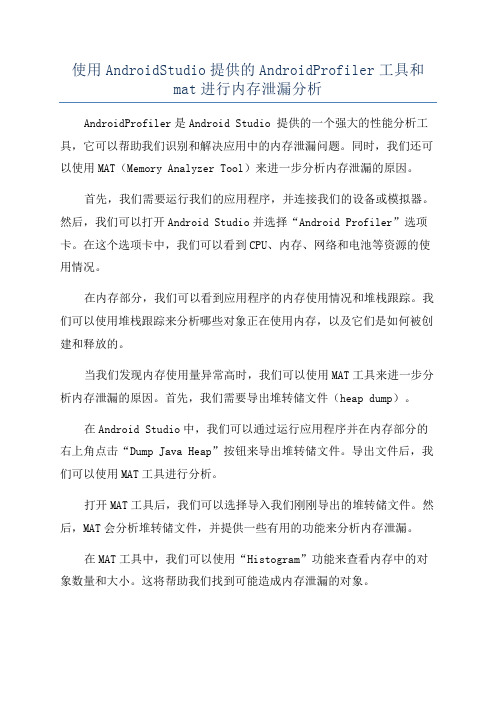
使用AndroidStudio提供的AndroidProfiler工具和mat进行内存泄漏分析AndroidProfiler是Android Studio 提供的一个强大的性能分析工具,它可以帮助我们识别和解决应用中的内存泄漏问题。
同时,我们还可以使用MAT(Memory Analyzer Tool)来进一步分析内存泄漏的原因。
首先,我们需要运行我们的应用程序,并连接我们的设备或模拟器。
然后,我们可以打开Android Studio并选择“Android Profiler”选项卡。
在这个选项卡中,我们可以看到CPU、内存、网络和电池等资源的使用情况。
在内存部分,我们可以看到应用程序的内存使用情况和堆栈跟踪。
我们可以使用堆栈跟踪来分析哪些对象正在使用内存,以及它们是如何被创建和释放的。
当我们发现内存使用量异常高时,我们可以使用MAT工具来进一步分析内存泄漏的原因。
首先,我们需要导出堆转储文件(heap dump)。
在Android Studio中,我们可以通过运行应用程序并在内存部分的右上角点击“Dump Java Heap”按钮来导出堆转储文件。
导出文件后,我们可以使用MAT工具进行分析。
打开MAT工具后,我们可以选择导入我们刚刚导出的堆转储文件。
然后,MAT会分析堆转储文件,并提供一些有用的功能来分析内存泄漏。
在MAT工具中,我们可以使用“Histogram”功能来查看内存中的对象数量和大小。
这将帮助我们找到可能造成内存泄漏的对象。
另一个有用的功能是“Leak Suspects”。
MAT会自动分析堆转储文件,并提供一些潜在的内存泄漏嫌疑对象。
我们可以点击这些对象来查看详细信息,包括对象的引用链。
通过分析引用链,我们可以找到内存泄漏的根本原因。
通常,内存泄漏是由于对象仍然保留了对其他对象的引用,导致这些对象无法被垃圾回收。
一旦我们找到了内存泄漏的原因,我们可以采取相应的措施来解决问题。
这可能包括释放不必要的引用、使用弱引用或软引用来避免长时间持有对象等。
检测内存泄露的方法

检测内存泄露的方法
1. 手动检查代码:内存泄漏通常是由于程序未正确释放动态分配的内存造成的,因此,开发人员可以手动审查他们的代码,以确保内存管理的正确性。
2. 静态代码分析工具:静态代码分析工具(如PVS-Studio、Coverity等)可以检测代码中的潜在问题和内存泄漏。
他们分析代码以查找未释放的内存和其它资源。
3. 动态代码分析工具:动态代码分析工具(如Valgrind、Dr.Memory等)可以模拟应用程序的执行,并跟踪内存的分配和释放。
这些工具可以检测内存泄漏和其它内存管理问题。
4. 内存分析工具:内存分析工具(如Heap Profiler、Memory Analyzer等)可以帮助开发人员识别内存泄漏并找到其原因。
他们可以跟踪内存分配和释放,并生成详细的报告,以帮助开发人员定位问题。
5. 内存泄漏检测工具:内存泄漏检测工具(如LeakCanary等)专门用于检测Android平台上的内存泄漏。
他们可以在应用程序中检测出未释放的对象,并
提供详细的报告和堆栈跟踪,以帮助开发人员找到问题所在。
android项目内存泄露排查

现象一:项目XXX在真机或者模拟器上操作一段时间后,应用突然黑屏然后恢复界面,但是Applilcation中保存的全局变量全部丢失。
排查步骤:1.检查logcat日志,没有发现从项目XXX代码抛出的异常,只发现一条:INFO/ActivityManager(209): Process com.xxx (pid 18396) has died.说明进程死掉了,应用被重启了,所有类都被初始化。
初步推测是内存泄漏导致进程被kill了。
2.排查内存泄漏,打开ddms,update heap视图,然后测试应用。
最终发现在某两个界面来回切换时,heap堆空间占用会持续增长,最终进程重启。
3.打开ddms 中的update heap视图,重复切换问题页面,当发现heap快被撑爆时生成dump文件。
用MAT分析,发现自定义的Application对象中有个List聚集了大量的某个Activity的Context引用,导致该很多Activity占用的heap内存泄漏,修改代码后该泄漏点解决,再测试时候打开update heap 视图监测heap内存占用情况,一切正常。
总结:1.Application对象的生命周期与整个App的生命周期一致,可以用来存放全局变量,但是注意不要引起内存泄露。
2.系统给应用的heap堆内存是动态分配的,不够了会增加,但是有上限,约24MB。
如果长时间低于30%左右used,堆内存会被系统回收一部分。
现象二:上一次heap堆内存泄漏解决后没过两天,测试发现同样是上一次的两个activity来回切换,在android2.3.5上会进程重启,而android4.0.3上一切正常。
排查步骤:1.分别在android2.3.5和android4.0.3上监测heap使用情况,来回切换问题页面,发现heap堆内存使用情况一切正常,内存使用率都稳定在50%左右。
但是在andorid2.3.5上如此操作一段时间后进程会重启,但是在android4.0.3上不会重启,这次感觉不像是内存泄漏。
在Android Studio中分析内存泄漏

在Android Studio中分析内存泄漏内存泄漏是开发过程中常见的问题之一,在Android应用程序中尤为突出。
当我们在开发应用时忽略了内存管理,或者对内存泄漏的检测不够敏感,就容易造成内存泄漏。
而Android Studio作为一款强大的集成开发环境,提供了丰富的工具和功能来帮助我们分析和解决内存泄漏问题。
本文将介绍如何在Android Studio中分析内存泄漏,并提供一些常见的解决方案。
一、内存泄漏的概念及影响内存泄漏是指在程序中分配了一块内存后,由于某种原因导致无法再次访问和释放这块内存,从而造成内存的浪费。
在Android应用中,内存泄漏的存在会导致一系列问题,包括但不限于:1. 应用程序占用内存过高,导致系统资源消耗过多,从而影响整体性能;2. 应用程序运行速度变慢,响应时间延长,用户体验差;3. 频繁的垃圾回收(Garbage Collection)导致界面卡顿或卡死。
二、分析工具介绍Android Studio提供了一些实用的工具和插件,帮助我们检测和分析内存泄漏。
以下是其中一些常用的工具和插件:1. Android Profiler:官方内置的性能分析工具,可以监控应用的CPU、内存、电量等性能数据,并提供实时的数据图表展示,帮助我们发现内存泄漏的位置。
2. LeakCanary:一款非常流行的开源库,专门用于检测内存泄漏。
只需要引入该库,并通过简单的配置即可在应用中实时检测内存泄漏,并生成详细的分析报告。
3. MAT(Memory Analyzer Tool):一款功能强大的Java内存分析器,可以用于分析Java应用程序的内存占用情况、泄漏对象的引用链等。
三、使用Android Profiler进行内存泄漏分析1. 打开Android Studio,点击顶部工具栏的"Profiler"按钮进入Android Profiler界面。
2. 在Android Profiler界面,选择"Memory"选项卡,可以看到应用程序的内存使用情况图表。
如何查看手机cpu使用率
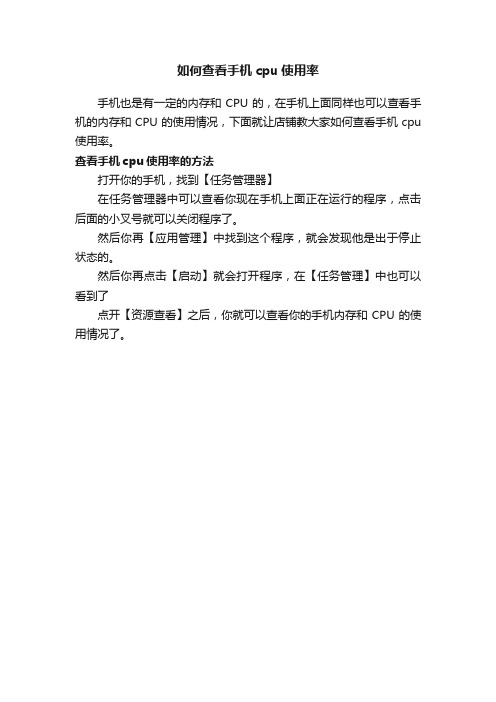
如何查看手机cpu使用率
手机也是有一定的内存和CPU的,在手机上面同样也可以查看手机的内存和CPU的使用情况,下面就让店铺教大家如何查看手机cpu 使用率。
查看手机cpu使用率的方法
打开你的手机,找到【任务管理器】
在任务管理器中可以查看你现在手机上面正在运行的程序,点击后面的小叉号就可以关闭程序了。
然后你再【应用管理】中找到这个程序,就会发现他是出于停止状态的。
然后你再点击【启动】就会打开程序,在【任务管理】中也可以看到了
点开【资源查看】之后,你就可以查看你的手机内存和CPU的使用情况了。
Android获取设备CPU核数、时钟频率以及内存大小的方法

Android获取设备CPU核数、时钟频率以及内存⼤⼩的⽅法本⽂实例讲述了Android获取设备CPU核数、时钟频率以及内存⼤⼩的⽅法。
分享给⼤家供⼤家参考,具体如下:因项⽬需要,分析了⼀下 Facebook 的开源项⽬ - Device Year Class。
Device Year Class 的主要功能是根据 CPU核数、时钟频率以及内存⼤⼩对设备进⾏分级。
代码很简单,只包含两个类: DeviceInfo -> 获取设备参数, YearClass -> 根据参数进⾏分级。
下表是 Facebook 公司提供的分级标准,其中 Year 栏表⽰分级结果。
Year Cores Clock RAM20081528MHz192MB2009n/a600MHz290MB2010n/a 1.0GHz512MB20112 1.2GHz1GB20124 1.5GHz 1.5GB2013n/a 2.0GHz2GB2014n/a>2GHz>2GB 关于输出年份的计算⽅法可以参考源码,本⽂只把⼀些⽐较常⽤的功能抽取出来做⼀个简要介绍。
获取 CPU 核数我们都知道,Linux 中的设备都是以⽂件的形式存在,CPU 也不例外,因此 CPU 的⽂件个数就等价与核数。
Android 的 CPU 设备⽂件位于 /sys/devices/system/cpu/ ⽬录,⽂件名的的格式为 cpu\d+。
root@generic_x86_64:/sys/devices/system/cpu # lscpu0cpufreqcpuidlekernel_maxmodaliasofflineonlinepossiblepowerpresentuevent统计⼀下⽂件个数便可以获得 CPU 核数。
public static int getNumberOfCPUCores() {if (Build.VERSION.SDK_INT <= Build.VERSION_CODES.GINGERBREAD_MR1) {// Gingerbread doesn't support giving a single application access to both cores, but a// handful of devices (Atrix 4G and Droid X2 for example) were released with a dual-core// chipset and Gingerbread; that can let an app in the background run without impacting// the foreground application. But for our purposes, it makes them single core.return 1;}int cores;try {cores = new File("/sys/devices/system/cpu/").listFiles(CPU_FILTER).length;} catch (SecurityException e) {cores = DEVICEINFO_UNKNOWN;} catch (NullPointerException e) {cores = DEVICEINFO_UNKNOWN;}return cores;}private static final FileFilter CPU_FILTER = new FileFilter() {@Overridepublic boolean accept(File pathname) {String path = pathname.getName();//regex is slow, so checking char by char.if (path.startsWith("cpu")) {for (int i = 3; i < path.length(); i++) {if (path.charAt(i) < '0' || path.charAt(i) > '9') {return false;}}return true;}return false;}};获取时钟频率获取时钟频率需要读取系统⽂件 - /sys/devices/system/cpu/cpu0/cpufreq/cpuinfo_max_freq 或者 /proc/cpuinfo。
android如何查看cpu的占用率和内存泄漏

一、通过eclipse,ADT开发工具的DDMS来查看(Heap)在“Devices”窗口中选择模拟器中的一个需要查看的程序,从工具条中选“Update heap”按钮,给这个程序设置上“heap Updates”,然后在Heap视图中点击Cause GC就可以实时显示这个程序的一些内存和cpu的使用情况了然后就会出现如下界面:说明:a) 点击“Cause GC”按钮相当于向虚拟机请求了一次gc操作;b) 当内存使用信息第一次显示以后,无须再不断的点击“Cause GC”,Heap视图界面会定时刷新,在对应用的不断的操作过程中就可以看到内存使用的变化;c) 内存使用信息的各项参数根据名称即可知道其意思,在此不再赘述。
大致解析如下:这个就是当前应用的内存占用,allocated 是已经分配的内存free是空闲内存,heap size 是虚拟机分配的不是固定值heap size 的最大值跟手机相关的有网友说,一般看1byte的大部分就是图片占用的如何判断应用是否有内存泄漏的可能性呢?如何才能知道我们的程序是否有内存泄漏的可能性呢。
这里需要注意一个值:Heap视图中部有一个Type叫做data object,即数据对象,也就是我们的程序中大量存在的类类型的对象。
在data object一行中有一列是“Total Size”,其值就是当前进程中所有Java数据对象的内存总量,一般情况下,这个值的大小决定了是否会有内存泄漏。
可以这样判断:a) 不断的操作当前应用,同时注意观察data object的Total Size值;b) 正常情况下Total Size值都会稳定在一个有限的范围内,也就是说由于程序中的的代码良好,没有造成对象不被垃圾回收的情况,所以说虽然我们不断的操作会不断的生成很多对象,而在虚拟机不断的进行GC的过程中,这些对象都被回收了,内存占用量会会落到一个稳定的水平;c) 反之如果代码中存在没有释放对象引用的情况,则data object的Total Size值在每次GC 后不会有明显的回落,随着操作次数的增多Total Size的值会越来越大,直到到达一个上限后导致进程被kill掉。
查看Android内存的8中方法
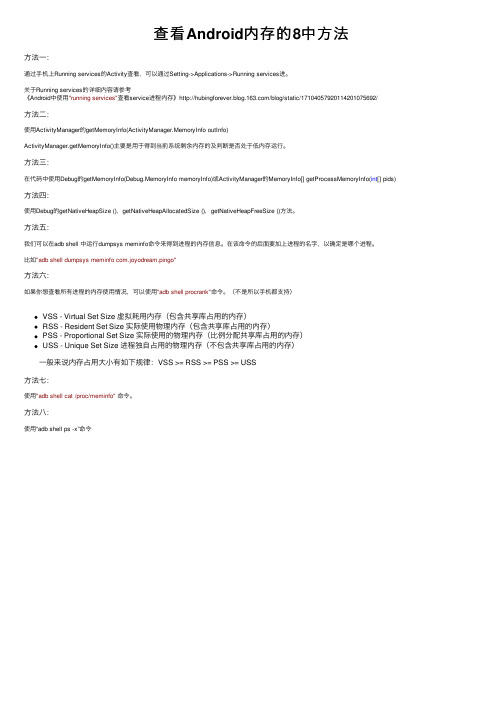
查看Android内存的8中⽅法⽅法⼀:通过⼿机上Running services的Activity查看,可以通过Setting->Applications->Running services进。
关于Running services的详细内容请参考《Android中使⽤"running services"查看service进程内存》/blog/static/17104057920114201075692/⽅法⼆:使⽤ActivityManager的getMemoryInfo(ActivityManager.MemoryInfo outInfo)ActivityManager.getMemoryInfo()主要是⽤于得到当前系统剩余内存的及判断是否处于低内存运⾏。
⽅法三:在代码中使⽤Debug的getMemoryInfo(Debug.MemoryInfo memoryInfo)或ActivityManager的MemoryInfo[] getProcessMemoryInfo(int[] pids)⽅法四:使⽤Debug的getNativeHeapSize (),getNativeHeapAllocatedSize (),getNativeHeapFreeSize ()⽅法。
⽅法五:我们可以在adb shell 中运⾏dumpsys meminfo命令来得到进程的内存信息。
在该命令的后⾯要加上进程的名字,以确定是哪个进程。
⽐如"adb shell dumpsys meminfo com.joyodream.pingo"⽅法六:如果你想查看所有进程的内存使⽤情况,可以使⽤"adb shell procrank"命令。
(不是所以⼿机都⽀持)VSS - Virtual Set Size 虚拟耗⽤内存(包含共享库占⽤的内存)RSS - Resident Set Size 实际使⽤物理内存(包含共享库占⽤的内存)PSS - Proportional Set Size 实际使⽤的物理内存(⽐例分配共享库占⽤的内存)USS - Unique Set Size 进程独⾃占⽤的物理内存(不包含共享库占⽤的内存) ⼀般来说内存占⽤⼤⼩有如下规律:VSS >= RSS >= PSS >= USS⽅法七:使⽤"adb shell cat /proc/meminfo"命令。
Androidcpu过高,内存泄露等调试手段

Androidcpu 过高,内存泄露等调试手段在Android 的应用开发中,我们会用到各种代码调试;其实在Android 的开发之后,我们可能会碰到一些随机的问题,如cpu 过高,内存泄露等,我们无法简单的进行代码调试,我们需要一个系统日志等等,下面我把握工作中碰到的几个常用命令和方法给大家演示实践一下。
1.logcat 命令这个命令最简单常用,可查看帮助,我不多说,如果需要打印时间,加参数-v time1 a db logcat -v time2.bugreport 命令这个命令也非常简单,但是在实际应用中非常有用,会有从开机之后详细的dumpsys,dumpstate 和logcat 信息,是一份完整的日志记录。
对分析用户行为,异常信息,系统状态有很大的参考作用。
一般我们会把bugreport 导出到电脑上分析。
1 a db bugreport > xxx.log我再次强调,bugreport 里面包含丰富的系统和用户信息,它是其他很多命令输出的结果的记录,非常有用。
3.dumpsys 命令这个查看系统信息,用的还是比较多的.1 2 3 4 5 6 7 dumpsys [options]meminfo 显示内存信息cpuinfo 显示CPU 信息account 显示accounts 信息activity 显示所有的activities 的信息window 显示键盘,窗口和它们的关系 wifi 显示wifi 信息例如查看某个程序内存信息:1 2 #查看应用com.tianxia.test 的内存使用情况adb shell dumpsys meminfo com.tianxia.test效果图如下:里面的信息很有价值,尤其对于分析内存泄露,内存溢出都有极大的作用。
4.top 命令这个查看cpu 信息太方便了。
1 t op -m 5 -t我们看看效果图,其中按cpu 大小列出5个进程列表。
android 获取cpu信息

android 获取cpu信息android获取cpu信息android获取cpu信息的方法1、cpu频率,cpu信息:/proc/cpuinfo和/proc/stat通过读取文件/proc/cpuinfo系统cpu的类型等多种信息。
加载/proc/stat所有cpu活动的信息去排序cpu使用率下面我们就来讲讲如何通过代码来获取cpu频率:packagecoorange.cpu;importjava.io.bufferedreader;importjava.io.filenotfoundexception;importjava.io.filereader;importjava.io.ioexception;importjava.io.inputstream;publicclasscpumanager{//获取cpu最大频率(单位khz)//"/system/bin/cat"命令行//"/sys/devices/system/cpu/cpu0/cpufreq/cpuinfo_max_freq"存储最大频率的文件的路径publicstaticstringgetmaxcpufreq(){stringresult="";processbuildercmd;try{string[]args={"/system/bin/cat","/sys/devices/system/cpu/cpu0/cpufreq/cpuinfo_max_freq"};cmd=newprocessbuilder(args);processprocess=cmd.start();inputstreamin=process.getinputstream();byte[]re=newbyte[24];while(in.read(re)!=-1){result=result+newstring(re);}in.close();}catch(ioexceptionex){ex.printstacktrace();result="n/a";}returnresult.trim();}//以获取cpu最轻频率(单位khz)publicstaticstringgetmincpufreq(){stringresult="";processbuildercmd;try{string[]args={"/system/bin/cat","/sys/devices/system/cpu/cpu0/cpufreq/cpuinfo_min_freq"}; cmd=newprocessbuilder(args);processprocess=cmd.start();inputstreamin=process.getinputstream();byte[]re=newbyte[24];while(in.read(re)!=-1){result=result+newstring(re);}in.close();}catch(ioexceptionex){ex.printstacktrace();result="n/a";}returnresult.trim();}//实时获取cpu当前频率(单位khz)publicstaticstringgetcurcpufreq(){stringresult="n/a";try{filereaderfr=newfilereader("/sys/devices/system/cpu/cpu0/cpufreq/scaling_cur_freq"); bufferedreaderbr=newbufferedreader(fr);stringtext=br.readline();result=text.trim();}catch(filenotfoundexceptione){e.printstacktrace();}catch(ioexceptione){e.printstacktrace();}returnresult;}//获取cpu名字publicstaticstringgetcpuname(){try{filereaderfr=newfilereader("/proc/cpuinfo");bufferedreaderbr=newbufferedreader(fr);stringtext=br.readline();string[]array=text.split(":\\s+",2);for(inti=0;i<array.length;i++){}returnarray[1];}catch(filenotfoundexceptione){e.printstacktrace();}catch(ioexceptione){e.printstacktrace();}returnnull;}}2、内存:/proc/meminfopublicvoidgettotalmemory(){stringstr1="/proc/meminfo";stringstr2="";try{filereaderfr=newfilereader(str1);bufferedreaderlocalbufferedreader=newbufferedreader(fr,);while((str2=localbufferedreader.readline())!=null){ log.i(tag,"---"+str2);}}catch(ioexceptione){}}3、rom大小.2ctopubliclong[]getrommemroy(){long[]rominfo=newlong[2];//totalrommemoryrominfo[0]=gettotalinternalmemorysize();//availablerommemoryfilepath=environment.getdatadirectory();statfsstat=newstatfs(path.getpath());longblocksize=stat.getblocksize();longavailableblocks=stat.getavailableblocks();rominfo[1]=blocksize*availableblocks;getversion();returnrominfo;}publiclonggettotalinternalmemorysize(){filepath=environment.getdatadirectory();statfsstat=newstatfs(path.getpath());longblocksize=stat.getblocksize();longtotalblocks=stat.getblockcount();returntotalblocks*blocksize;}4、sdcard大小publiclong[]getsdcardmemory(){long[]sdcardinfo=newlong[2];stringstate=environment.getexternalstoragestate();if(environment.media_mounted.equals(state)){filesdcarddir=environment.getexternalstoragedirectory();statfssf=newstatfs(sdcarddir.getpath());longbsize=sf.getblocksize();longbcount=sf.getblockcount();longavailblocks=sf.getavailableblocks();sdcardinfo[0]=bsize*bcount;//总大小sdcardinfo[1]=bsize*availblocks;//需用大小}returnsdcardinfo;}5、电池电量privatebroadcastreceiverbatteryreceiver=newbroadcastreceiver(){ @overridepublicvoidonreceive(contextcontext,intentintent){intlevel=intent.getintextra("level",0);//level加%就是当前电量了}};registerreceiver(batteryreceiver,newintentfilter(intent.action_battery_changed ));6、系统的版本信息publicstring[]getversion(){string[]version={"null","null","null","null"};stringstr1="/proc/version";stringstr2;string[]arrayofstring;try{filereaderlocalfilereader=newfilereader(str1);bufferedreaderlocalbufferedreader=newbufferedreader(localfilereader,);str2=localbufferedreader.readline();arrayofstring=str2.split("\\s+");version[0]=arrayofstring[2];//kernelversionlocalbufferedreader.close();}catch(ioexceptione){}version[1]=build.version.release;//firmwareversionversion[2]=build.model;//modelversion[3]=build.display;//systemversionreturnversion;}7、mac地址和开机时间publicstring[]getotherinfo(){string[]other={"null","null"};wifimanagerwifimanager=(wifimanager)mcontext.getsystemservice(context.wifi_ser vice);wifiinfowifiinfo=wifimanager.getconnectioninfo();if(wifiinfo.getmacaddress()!=null){other[0]=wifiinfo.getmacaddress();}else{other[0]="fail";}other[1]=gettimes();returnother;。
获取android手机内存信息
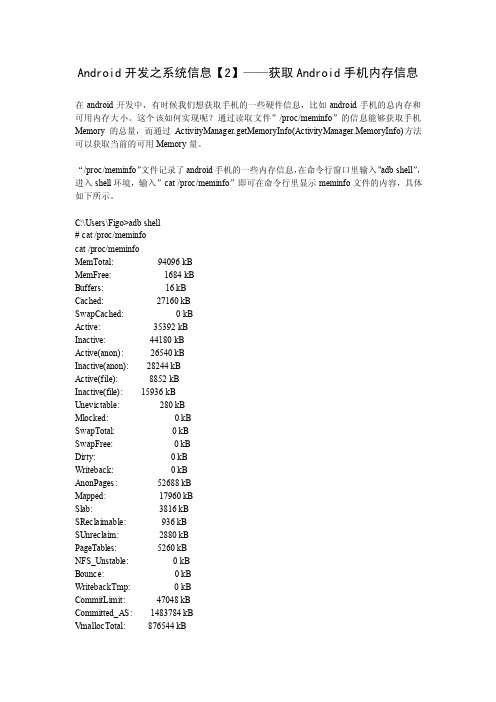
Android开发之系统信息【2】——获取Android手机内存信息在android开发中,有时候我们想获取手机的一些硬件信息,比如android手机的总内存和可用内存大小。
这个该如何实现呢?通过读取文件”/proc/meminfo”的信息能够获取手机Memory的总量,而通过ActivityManager.getMemoryInfo(ActivityManager.MemoryInfo)方法可以获取当前的可用Memory量。
“/proc/meminfo”文件记录了android手机的一些内存信息,在命令行窗口里输入”adb shell”,进入shell环境,输入”cat /proc/meminfo”即可在命令行里显示meminfo文件的内容,具体如下所示。
C:\Users\Figo>adb shell# cat /proc/meminfocat /proc/meminfoMemTotal: 94096 kBMemFree: 1684 kBBuffers: 16 kBCached: 27160 kBSwapCached: 0 kBActive: 35392 kBInactive: 44180 kBActive(anon): 26540 kBInactive(anon): 28244 kBActive(file): 8852 kBInactive(file): 15936 kBUnevictable: 280 kBMlocked: 0 kBSwapTotal: 0 kBSwapFree: 0 kBDirty: 0 kBWriteback: 0 kBAnonPages: 52688 kBMapped: 17960 kBSlab: 3816 kBSReclaimable: 936 kBSUnreclaim: 2880 kBPageTables: 5260 kBNFS_Unstable: 0 kBBounce: 0 kBWritebackTmp: 0 kBCommitLimit: 47048 kBCommitted_AS: 1483784 kBVmallocTotal: 876544 kBVmallocUsed: 15456 kBVmallocChunk: 829444 kB#下面先对”/proc/meminfo”文件里列出的字段进行粗略解释:MemTotal: 所有可用RAM大小。
掌握Android测试中的内存泄漏检测技巧

掌握Android测试中的内存泄漏检测技巧在Android开发中,内存泄漏是一个常见且严重的问题。
如果不及时检测和解决,内存泄漏会导致应用程序占用过多的内存,进而出现卡顿、崩溃等问题,严重影响用户体验。
本文将介绍一些掌握Android测试中的内存泄漏检测技巧,帮助开发者提高应用程序的性能和稳定性。
1. 内存泄漏的原因内存泄漏的本质是不再使用的对象没有被垃圾回收器正确地回收,导致占用的内存无法释放。
造成内存泄漏的主要原因包括以下几点:- 静态对象的持有:静态对象会一直存在于内存中,不会被垃圾回收器回收。
如果静态对象持有其他对象的引用,而这些对象不再使用,就会导致内存泄漏。
- 上下文引用的泄漏:在Android开发中,如果一个对象持有了Activity、Fragment等上下文的引用,当这些上下文关闭时,被持有的对象可能无法被垃圾回收器回收,从而引发内存泄漏。
- 定时器泄漏:如果在Activity或Fragment中使用定时器,没有及时取消定时器的任务,就可能导致Activity或Fragment无法被回收,进而引起内存泄漏。
- 资源未释放:如果使用了一些需要手动释放的资源,比如数据库连接、文件流等,如果忘记手动释放,就会造成内存泄漏。
- 匿名内部类的持有:匿名内部类会隐式地持有它所在外部类的引用,如果外部类没有被及时释放,就会导致内存泄漏。
2. 内存泄漏检测工具为了帮助开发者及时发现和解决内存泄漏问题,Android提供了一些实用的内存泄漏检测工具。
下面介绍几种常用的内存泄漏检测工具:- Android Profiler:Android Studio自带的性能分析工具,可以查看应用程序的内存使用情况,包括内存泄漏的检测与分析。
- LeakCanary:一个强大的开源工具,可以自动检测Android应用程序的内存泄漏,快速定位问题,并通过通知或日志方式提醒开发者。
- MAT(Memory Analyzer Tool):Eclipse插件,用于分析Java堆转储文件(heap dump files),帮助开发者找出内存泄漏的原因。
Android测试中的应用性能监控和分析技巧

Android测试中的应用性能监控和分析技巧在Android测试中的应用性能监控和分析技巧Android手机已经成为人们生活中不可或缺的伙伴,而应用性能的好坏对于用户体验来说至关重要。
为了保证应用的正常运行,Android测试中的应用性能监控和分析变得至关重要。
本文将介绍一些常用的Android应用性能监控和分析技巧,帮助开发人员和测试人员更好地评估和改进应用性能。
一、CPU性能监控在Android应用性能监控中,CPU是一个重要的指标。
可以通过以下几种方式监控CPU的使用情况:1. 使用Android自带的开发者选项:在手机设置中开启开发者选项,然后在开发者选项中找到"显示CPU使用情况"选项,勾选启用。
这样在屏幕顶部就会实时显示CPU的使用率,可以观察各个应用程序的CPU占用情况。
2. 使用第三方工具:如Performance Monitor,它提供了详细的CPU使用率和运行状态信息,可以通过图表和日志等方式展示,帮助分析CPU性能问题。
二、内存监控和分析应用程序在运行时会占用一定的内存资源,合理管理内存对于提高应用性能至关重要。
以下是一些常用的内存监控和分析技巧:1. 使用Android Studio中的Memory Profiler:Android Studio提供了强大的内存监控和分析工具,可以帮助开发人员分析内存泄漏以及内存使用情况等问题。
通过Memory Profiler,可以查看内存使用情况的变化曲线、堆栈信息、对象引用关系等,帮助定位和解决内存相关问题。
2. 使用MAT(Memory Analyzer Tool)进行分析:MAT是一款功能强大的Java堆转储分析工具,可以帮助开发人员深入研究内存转储文件,找到内存泄漏和优化内存使用的方式。
三、电量消耗监控电量消耗是用户使用手机应用时极为关注的一个指标。
为了提高应用的电量消耗效率,可以采取以下几种监控和分析技巧:1. 使用系统自带的电池使用情况查看:在Android设备的设置中,可以找到"电池"选项,查看应用程序的电量使用情况。
- 1、下载文档前请自行甄别文档内容的完整性,平台不提供额外的编辑、内容补充、找答案等附加服务。
- 2、"仅部分预览"的文档,不可在线预览部分如存在完整性等问题,可反馈申请退款(可完整预览的文档不适用该条件!)。
- 3、如文档侵犯您的权益,请联系客服反馈,我们会尽快为您处理(人工客服工作时间:9:00-18:30)。
android如何查看cpu的占用率和内存泄漏在分析内存优化的过程中,其中一个最重要的是我们如何查看cpu的占用率和内存的占用率呢,这在一定程度上很重要,经过查询资料,研究了一下,暂时了解到大概有以下几种方式,如果哪位高手有更好的办法,或者文中描述有错误,还望高手在下面留言,非常感谢!一、通过eclipse,ADT开发工具的DDMS来查看(Heap)在“Devices”窗口中选择模拟器中的一个需要查看的程序,从工具条中选“Update heap”按钮,给这个程序设置上“heap Updates”,然后在Heap视图中点击Cause GC就可以实时显示这个程序的一些内存和cpu的使用情况了。
然后就会出现如下界面:说明:a) 点击“Cause GC”按钮相当于向虚拟机请求了一次gc操作;b) 当内存使用信息第一次显示以后,无须再不断的点击“Cause GC”,Heap视图界面会定时刷新,在对应用的不断的操作过程中就可以看到内存使用的变化;c) 内存使用信息的各项参数根据名称即可知道其意思,在此不再赘述。
大致解析如下:这个就是当前应用的内存占用,allocated 是已经分配的内存free是空闲内存,heap size 是虚拟机分配的不是固定值heap size 的最大值跟手机相关的有网友说,一般看1byte的大部分就是图片占用的如何判断应用是否有内存泄漏的可能性呢?如何才能知道我们的程序是否有内存泄漏的可能性呢。
这里需要注意一个值:Heap视图中部有一个Type叫做data object,即数据对象,也就是我们的程序中大量存在的类类型的对象。
在data object一行中有一列是“Total Size”,其值就是当前进程中所有Java数据对象的内存总量,一般情况下,这个值的大小决定了是否会有内存泄漏。
可以这样判断:a) 不断的操作当前应用,同时注意观察data object的Total Size值;b) 正常情况下Total Size值都会稳定在一个有限的范围内,也就是说由于程序中的的代码良好,没有造成对象不被垃圾回收的情况,所以说虽然我们不断的操作会不断的生成很多对象,而在虚拟机不断的进行GC的过程中,这些对象都被回收了,内存占用量会会落到一个稳定的水平;c) 反之如果代码中存在没有释放对象引用的情况,则data object的Total Size值在每次GC 后不会有明显的回落,随着操作次数的增多Total Size的值会越来越大,直到到达一个上限后导致进程被kill掉。
d) 此处已system_process进程为例,在我的测试环境中system_process进程所占用的内存的data object的Total Size正常情况下会稳定在2.2~2.8之间,而当其值超过3.55后进程就会被kill。
在如下的位置:二、通过linux命令来查看常用的命令有adb shellps 是看进程的top命令是看占用率的3.获取最大内存的方法ActivityManager am = (ActivityManager) getSystemService(Context.ACTIVITY_SERVICE);am.getMemoryClass();这个是最大内存,如果超过这个内存就OOM了---------------------------------------内存耗用:VSS/RSS/PSS/USS 的介绍VSS - Virtual Set Size 虚拟耗用内存(包含共享库占用的内存)RSS - Resident Set Size 实际使用物理内存(包含共享库占用的内存)PSS - Proportional Set Size 实际使用的物理内存(比例分配共享库占用的内存)USS - Unique Set Size 进程独自占用的物理内存(不包含共享库占用的内存)一般来说内存占用大小有如下规律:VSS >= RSS >= PSS >= USSOverviewThe aim of this post is to provide information that will assist in interpreting memory reports from various tools so the true memory usage for Linux processes and the system can be determined.Android has a tool called procrank (/system/xbin/procrank), which lists out the memory usage of Linux processes in order from highest to lowest usage. The sizes reported per process are VSS, RSS, PSS, and USS.For the sake of simplicity in this description, memory will be expressed in terms of pages, rather than bytes. Linux systems like ours manage memory in 4096 byte pages at the lowest level.VSS (reported as VSZ from ps) is the total accessible address space of a process. This size also includes memory that may not be resident in RAM like mallocs that have been allocated but not written to. VSS is of very little use for determing real memory usage of a process.RSS is the total memory actually held in RAM for a process. RSS can be misleading, because it reports the total all of the shared libraries that the process uses, even though a shared library is only loaded into memory once regardless of how many processes use it. RSS is not an accurate representation of the memory usage for a single process.PSS differs from RSS in that it reports the proportional size of its shared libraries, i.e. if three processes all use a shared library that has 30 pages, that library will only contribute 10 pages to the PSS that is reported for each of the three processes. PSS is a very useful number because when the PSS for all processes in the system are summed together, that is a good representation for the total memory usage in the system. When a process is killed, the shared libraries that contributed to its PSS will be proportionally distributed to the PSS totals for the remaining processes still using that library. In this way PSS can be slightly misleading, because when a process is killed, PSS does not accurately represent the memory returned to the overall system.USS is the total private memory for a process, i.e. that memory that is completely unique to thatprocess. USS is an extremely useful number because it indicates the true incremental cost of running a particular process. When a process is killed, the USS is the total memory that is actually returned to the system. USS is the best number to watch when initially suspicious of memory leaks in a process.For systems that have Python available, there is also a nice tool called smem that will report memory statistics including all of these categories.# procrankprocrankPID Vss Rss Pss Uss cmdline481 31536K 30936K 14337K 9956K system_server475 26128K 26128K 10046K 5992K zygote526 25108K 25108K 9225K 5384K android.process.acore523 22388K 22388K 7166K 3432K com.android.phone574 21632K 21632K 6109K 2468K com.android.settings521 20816K 20816K 6050K 2776K jp.co.omronsoft.openwnn474 3304K 3304K 1097K 624K /system/bin/mediaserver37 304K 304K 289K 288K /sbin/adbd29 720K 720K 261K 212K /system/bin/rild601 412K 412K 225K 216K procrank1 204K 204K 185K 184K /init35 388K 388K 182K 172K /system/bin/qemud284 384K 384K 160K 148K top27 376K 376K 148K 136K /system/bin/vold261 332K 332K 123K 112K logcat33 396K 396K 105K 80K /system/bin/keystore32 316K 316K 100K 88K /system/bin/installd269 328K 328K 95K 72K /system/bin/sh26 280K 280K 93K 84K /system/bin/servicemanager45 304K 304K 91K 80K /system/bin/qemu-props34 324K 324K 91K 68K /system/bin/sh260 324K 324K 91K 68K /system/bin/sh600 324K 324K 91K 68K /system/bin/sh25 308K 308K 88K 68K /system/bin/sh28 232K 232K 67K 60K /system/bin/debuggerd#。
